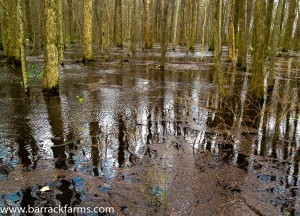This is a picture of the woodlot behind my house. It’s supposed to flood this way. I have a control structure (just behind me in the photo) that controls the water levels and creates what we call a “green tree reservoir” for wintering waterfoul. This is a little over 40 acres of water here which I will draw down as the trees leaf out in spring.
This is really great since we’ve had drought conditions here and the woods have been completely dry for the last 3 winters. The ducks are happy – and so am I.
Small woodlots like this still exist in the Mississippi delta only because the land was too wet for people to clear away for farming back in the early part of the last century. Where the land is relatively “high and dry”, trees are a thing of the past and industrial farming rules. Today, the government (the taxpayers) pay landowners to restore marginal areas where the forest never should have been cleared in the first place. With most of the forest gone, these small spaces become more and more important in the effort to restore previously destroyed habitats for wildlife, by acting as a biofilter for toxic farm runoff and to help replenish an ever diminishing water table that has been drawn down to critical levels by industrial farming.
We are lucky in the so called “lower” delta to have both the Delta National Forest and Panther Swamp National Wildlife refuge located within our borders. Overall, however, the delta is more generally characterized by deforestation, chemical pollution and poor soil conservation caused mostly by industrial farming interests.

